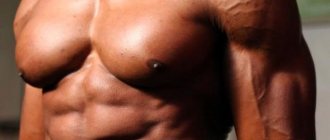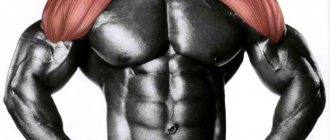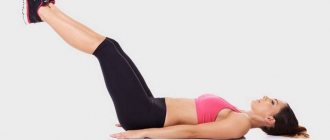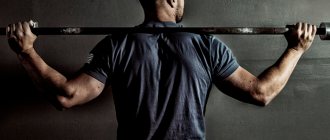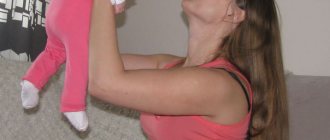#2 Do one-arm push-ups
During push-ups on one arm, you will get a fairly noticeable load on the triceps and lats. Try to do at least a dozen push-ups - you’re unlikely to succeed the first time.
However, if you have never done push-ups on one hand, go through our guide: in it we discussed in detail how to learn how to do push-ups on one hand from scratch in 3 steps .
Push-ups for muscle growth
All strength exercises can build muscle if done with technique, volume and intensity appropriate to the level of muscle development. The larger the muscles, the more complex the technique, the greater the volume and the higher the intensity.
Push-ups are no exception.
Even for an experienced athlete, I can choose a push-up technique that, with low volume and intensity, creates conditions for muscle growth.
For example, I can create a muscle load equivalent to a bench press of 100 kilograms in push-ups. For a small athlete like me, bench pressing a 100 kg barbell for 10 reps in 10 sets is about the limit of natural muscle growth, and at a pace of 6 seconds per repetition and with a density of 2 minutes per set - “a completely impossible load” for a natural person .
Here are the basic principles that you need to be able to apply in a specific situation for your level of development.
The minimum volume for beginners is 75 approaches per week. Experienced amateurs do 120 approaches per week. On vacation, I increased the volume to 300 approaches. 300 approaches is very effective, but on vacation.
The intensity of the approach is determined by the technique, tempo and density of the approach.
My approach pace ranges from 3 to 6 seconds per repetition. A set of 15 push-ups can be done in 45 to 90 seconds.
The approach density is usually 3 minutes per approach. Sometimes 2 minutes.
The technique can vary depending on the desire to load the desired muscle: with wide elbows for the chest, a narrow grip for the triceps, or a round back for the deltoids.
Obviously, 15 push-ups with wide elbows, at a pace of 3 seconds per repetition and with a density of 3 minutes per set are incomparably easier than the same 15 push-ups with a round back at a pace of 6 seconds per repetition and with a density of 2 minutes per set.
Even an experienced athlete can become confused by these muscle growth stimulation tools. But they need to be used in time to provide the optimal load and avoid getting into a state of overtraining or injury.
Against training and a plan, the main thing is to adhere to the principles: the finish line and minus one.
#3 Put your feet up
The easiest way to increase the load is to place your feet on a bed or chair. The higher they are, the more of the weight will be on your hands. As an option, they can be placed on a fitball. Unstable support will activate stabilizer muscles , which will come in handy when working with free weights.
Elevated push-ups will force the top of your pecs to work, something that almost never happens during regular push-ups. Well, if you use a weight in the form of a backpack, they will definitely say “thank you.”
The most extreme version of elevated push-ups is to throw them up against a wall and perform push-ups upside down . The technique will make you sweat, but the front and middle deltoids will be involved in the work. If you want to learn, read our material on the topic.
Typical mistakes of athletes
Back-to-bench triceps push-ups are a technically simple isolation exercise and don't have as many pitfalls as, for example, the close-grip bench press. However, the technical errors described below will prevent you from getting the maximum benefit from this exercise, and if you recognize yourself in any of these points, adjustments to your technique will need to be made immediately. In order to learn how to properly do push-ups from a bench from behind your back, watch a couple of training videos on the Internet or contact a personal trainer at your gym.
There is discomfort - don't do it
Do not perform the exercise if you feel discomfort in your shoulders or elbows while doing it. Take care of your body (restoring cartilage tissue is a long, expensive and unpleasant process). It is better to replace this exercise with any other isolated exercise that works the triceps, for example, extensions from the upper block.
Hands too wide
Do not place your hands too wide on the bench; the optimal width is slightly wider than shoulder level. By spreading your arms too far to the sides, it will be more difficult for you to control their position. You may unknowingly push them inside, risking injury to your elbow joints and ligaments.
Don't linger in the upper phase
Do not linger too long at the top point with your arms fully extended - there is too much stress on your elbows. It is best to work non-stop, without fully extending your arms at the top point. This will provide the triceps with the greatest blood supply.
Injuries to joints and ligaments
Be especially careful when performing this exercise if you have previously had injuries to your joints and ligaments. Warm up thoroughly, use elastic bands, and perform the movement as smoothly and under control as possible.
Be careful with weights
Don't overdo it with additional weights. If your triceps are already well developed, then the main strength load should be obtained from basic exercises performed with free weights. In this case, leave the bench push-ups for the end of the workout. Such a scheme will help to comprehensively develop the triceps muscle of the shoulder and achieve good relief.
Do not combine with parallel bars
Do not perform push-ups and dips in the same workout. These exercises have almost the same biomechanics, and you risk simply overtraining your muscles.
The support must be solid
Do not perform the exercise on an unstable or soft surface. This way you will be too distracted by the position of your arms and legs, and you will hardly be able to concentrate on working your triceps.
Don't experiment
Do not make unnecessary experiments in your triceps training - all the truly “working” things have already been invented before us. Several times I had to observe the following picture. During push-ups, the athlete leaned on the bench not with his palms, but with his fists, while his elbows “walked” from side to side. It makes no sense to do this, and your hands can be well strengthened with the help of other exercises without resorting to such amateur activities.
#4 Do corner push-ups
This option is perfect for those who are hesitant to do push-ups upside down, but want to complicate the technique. Unlike many other push-up options, this one focuses on the deltoid muscles , and this is a huge plus.
Technique
- Position yourself so that your feet are shoulder-width apart and the angle between your hips and body is 90 degrees.
- Lower yourself down, spreading your elbows to the sides until your head is just a few centimeters from the floor.
- Pause and slowly return to the starting position.
Training program
For exercise, it is enough to allocate one day a week, but how many push-ups you need to do per day in order to pump up, everyone decides on their own due to the characteristics of their own body. Professionals recommend alternating loads, and for a certain part of the body there should be a minimum break of 48 hours. The number of repetitions in push-ups is minimal, so the entire training will not take much time. Between approaches you can take short breaks to rest. Three approaches are recommended for each type of push-up, but to lose weight you need to increase the number of repetitions to 50 times in one approach.
The following exercises can be included in the whole body pumping program:
- Alternating push-ups: 20 reps. The starting position is standard, but the movements are performed on one side. The weight of the body should rest as much as possible on one shoulder. The movements on the other side are identical.
- Rearranged push-ups: 20 reps. In the standard position, one hand should be in front of the shoulder. Moving down and up is classic. When performing approaches, the position of the palms is changed by rearranging or jumping.
- Diamond push-ups: 10 reps. This exercise can effectively work your triceps. The palms are positioned so that a triangle is formed between the thumb and index finger. The range of motion is quite wide, the chest should almost touch the fingers.
- Impact push-ups – 10 repetitions. The starting position is standard, the downward movement is also classic. You need to push off from the floor sharply, and during this time have time to touch your chest with both palms. The return to the starting position should be quick.
- Single leg push-ups – 10 reps. When lifting one limb from a lying position, the buttocks are tense. The movements are classic, but you need to change your leg with each approach.
Alexander Shestov
TRX Certified Trainer
Ask a Question
This training program does not need to be supplemented with other exercises for weeks. But to increase the load and increase muscle mass, you can consider some additional exercises.
Chest muscle training
Corkscrew push-ups are performed from the standard position, but the hands should be in front of the shoulders. When bending the elbows, it is recommended to rotate the hips, which is performed first in one direction and then in the opposite direction.
Placing your palms in front of your shoulders increases the load on the deltoids. By turning, the lower press is included in the process.
Is it possible to get pumped up with push-ups if you use the exercise with your arm outstretched? When moving down in this case, you need to extend one arm to the side, and during the second approach it changes to the other. The variation seems simple, but it puts maximum stress on the small stabilizing muscles of the shoulder, which help maintain balance. Therefore, you won’t be able to get pumped up with this exercise.
The hip lift variation is called the Dive Bomber and is performed from a standard starting position. Not the entire body rises up, but only the buttocks, the head and chest remain below. When straightening your arms, your shoulders and back should be at the top, and your hips and legs should move down. The exercise has a good effect on the muscles of the shoulders and back.
The trainer decides how many times you need to do push-ups using the platform in the gym, since the exercises are considered dynamic. In the initial state, the hands are placed on a special simulator. With a crossover, it becomes clear whether it is possible to pump up muscles with push-ups and pump up your chest with simple movements after the first workout. From a height, the movement down is slow, and up is fast, while you need to have time to move your palms to the floor. The return to the starting position is non-stop.
Without proper dexterity, there is a risk of injury, as you can hit your chin on the platform.
At a higher elevation, you can perform exercises with one hand. This type of push-up is also called a cross push-up. For example, in the initial state, the left hand can be placed on the floor and the right hand on the platform. When repeating the approach, the position of the hands changes.
Diamond push-ups can also be performed on a platform. When placing your palms, a triangle should form between the thumb and index finger. This exercise has a positive effect on the middle and lower chest.
#5 Do jumping push-ups
These push-ups are otherwise called plyometric push-ups . Perhaps by themselves they will not create a strong load on the target muscles, but they will work well for developing explosive strength and will allow you to increase strength indicators, including in bench presses. Explosive strength is also useful in team sports, such as volleyball and basketball.
The rules are simple: at the bottom point you need to push off with your hands and jump so that your palms come off the floor.
Over time, the technique can be complicated: for example, clapping your hands while jumping in front of you or behind your back. The number of claps can also be increased.
Types of push-ups
Pushups
I don’t think there’s much point in explaining how push-ups are performed. From childhood, everyone knows how to do this most basic exercise. I will only note that depending on the position of the hands, the muscles will be loaded differently. The wider the arms are positioned and the elbows spread to the sides, the more the load falls on the pectoral muscles. The narrower the position of the arms and the closer the elbows are to the body, the more the load goes into the triceps and deltoids.
Accordingly, push-ups are possible with a narrow (palms side by side), medium (palms shoulder-width apart) and wide (palms at the level of the elbows spread out to the sides) grip.
In addition, you can slightly shift your palms in height: at chest level, at shoulder level, at head level. You can also “play” by turning your palms.
All these nuances will play a role in muscle training.
I recommend slightly changing the position of your hands in different approaches, this will allow you to shift the load and involve a larger number of muscle fibers in the training, that is, pump all the muscles involved more strongly. In this case, you should choose hand positions in which you will feel comfortable performing the approaches.
Do 2-3 approaches with different hand positions. Rest between sets for 1-3 minutes.
And make sure that during the approaches the pelvis does not protrude upward or sag downwards; these are the main and most common mistakes in this exercise.
Push-ups for girls
It is worth noting that girls have weaker upper body muscles than men. Therefore, women may require a certain preparatory period with light loads.
To lighten the load in push-ups, you can use 2 options. You can do push-ups while lying on the floor, but focus on your knees, not your feet. This will significantly reduce the load on the torso (abs, back), and also slightly reduce the load on the arms and chest.
The second method is to place a chair or stool under your arms. That is, you do push-ups at an angle of approximately 30º, with your head higher than your feet. This significantly eases the load on the target muscles.
As you train, you can reduce the incline and gradually move on to standard push-ups.
Push-ups for men
For men, the challenge is the opposite: how to make push-ups more difficult. There are many ways to do this, we list them:
- push-ups from the floor with legs supported on a chair or stool;
- one-arm push-ups;
- push-ups with clap;
- push-ups with fists;
- push-ups with additional weights.
#6 Do push-ups using your fist or fingers
The whole point of this version of push-ups is that the distance from the chest to the floor increases. The range of motion increases , and the muscles need to do more work to get to the bottom point and get out of it to the top. That is, performing this option is more difficult than regular push-ups.
In addition, finger push-ups strengthen your wrists and work on grip strength, which you will need in the lion's share of compound exercises, including barbell presses and pull-ups.
To avoid injury, it is better to start with a static plank on your fingers. Time after time, increase the time you spend in the plank. Then, start adding push-ups to the plank. You can start with half the amplitude and end with full amplitude.
You need to do push-ups using your fingertips, not your tips. In the latter case, it is easy to get injured.
As an option, you can do push-ups on special spacers, weights or dumbbells. The principle is the same - increasing the distance to the floor and the range of motion.
lateral delts deltoid calaesthetics pectoral anterior delts Triceps grip
Tips and tricks
You already know whether you can pump yourself up with push-ups or pull-ups. Now we would like to give you some recommendations that will help in your training.
- Remember safety! Before each training session, be sure to warm up to prepare your muscles and joints for subsequent loads and warm them up. This will help you avoid serious injuries while performing this or that exercise.
- Don't just do push-ups and pull-ups. If you want to build a beautiful and athletic physique, then in addition to these exercises, you need to do other types of physical activity.
- Don't forget about recovery! If your goal is to gain muscle mass, then remember that muscles do not grow during training, but after it, that is, during rest. Supplement your diet with protein foods.
We have brought to your attention an article about whether it is possible to pump up with push-ups. We hope this information was useful to you!
How to do push-ups correctly to pump up your arms?
Exercises for working with your own weight are loved by everyone due to their accessibility and effectiveness.
Combining these 2 indicators, they have become widespread in all sports. For some, they have become the main tool for shaping the body, and for others - an additional one. One such exercise is push-ups. Practical, versatile and effective - they are popular among both schoolchildren and professional athletes.
In push-ups, you can vary the load by shifting the position of your hands.
Progression of the pectoral muscles: a real-life example
The person I gave as an example, working out simply out of boredom, was able to pump up his pectoral muscles to some extent. I must say that before training they were not visible at all. The asthenic chest was flat, like an ironing board.
Training in the hospital
A man was hospitalized due to inflammation of the digestive tract.
The first couple of days he came to his senses after prolonged abdominal pain. As soon as his condition improved, he became bored of just lying there and doing nothing. Oh yes, we are talking about a guy who is 17 years old.
The patient was lying alone in the ward. You know what the beds in hospitals are like. No, not in modern private wards, where everything was done according to different drawings a long time ago. A regular bed with a removable headrest.
Out of boredom and already feeling well at that time, the man decided to train - in a hospital setting he could pump up his abs and do push-ups. He began doing push-ups on the floor.
First results
When regular push-ups began to tire (by the way, from 8 push-ups at a time, during the month he spent in the hospital, he reached 50), a new element was included in the training - push-ups from the bed frame.
And the last stage of training - he moved the beds together and used their arms as bars. After a month of such training, his pectoral muscles began to stand out noticeably. They were small but noticeable. This was enough for friends and relatives to notice the changes. The triceps also became more defined and sculpted.
The exercises had side effects - periodic training caused a re-exacerbation of pain. Therefore, doctors extended hospital treatment. But each time the pain subsided faster and faster. When the body adapted to the load, the pain went away completely.
No one told the doctors about this practice. Otherwise, the “athlete” would quickly be discharged from the free “gym.”
Here's a story about how you can change yourself with just your own body and even hospital food. Of course, I do not recommend such experiments to anyone. This is just an example of what happens in life.
Watch your diet, give your muscles a good workout, be healthy and strong!
Is it possible to pump up muscles with push-ups - the subtleties of gaining weight
The material was prepared by the site team with the support of our experts: athletes, coaches and nutrition specialists. Our team >>
- Reading time: 5 min.
- What works and what doesn't about push-ups
- Weights: necessary or not
- Movement speed
- Training protocol
- Different types of push-ups and their effects
- What else will help you pump up?
- Nutrition and sleep
- Progression of the pectoral muscles: a real-life example
- Training in the hospital
- First results
Can you get pumped up with push-ups? Let's leave out philosophy, the reasoning of armchair fighters and just theorists. Instead, let's take a few practical recommendations on how to pump up muscles with push-ups in a short time. And then there will be a real story from the life of a man I knew.

